32 Best-Deer Resistant Flowers and Plants to Grow
Varieties that deer are likely to avoid
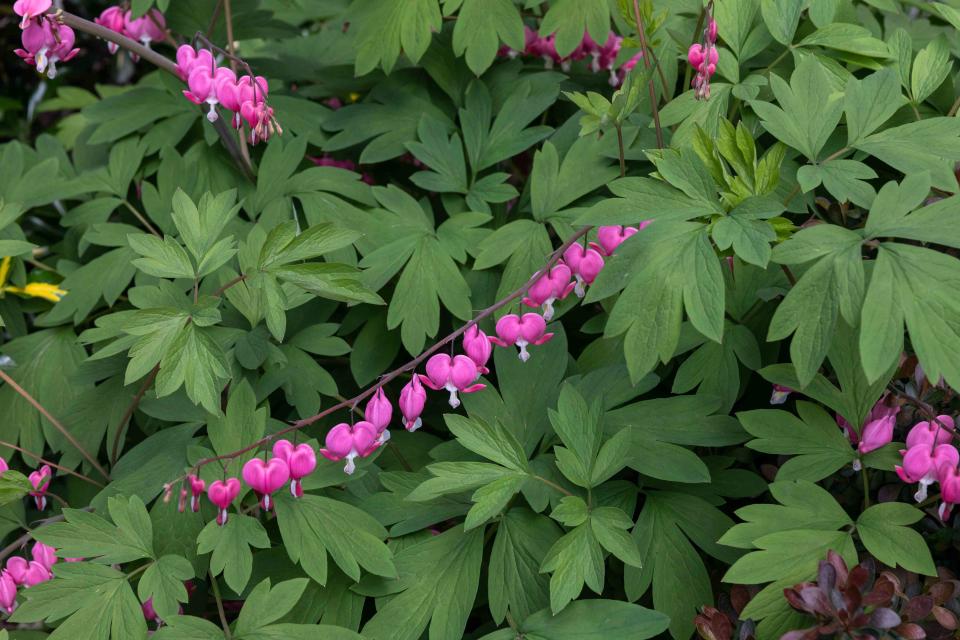
The Spruce / Leticia Almeida
Reviewed by Debra LaGattutaFact checked by Alexandra Kay
While many flowers and shrubs make a tasty meal for roaming deer, you can avoid damage by planting species deer are not likely to eat in your garden. Deer-resistant flowers and foliage are often fragrant, toxic, or have a rough or odd texture.
You can try various methods to keep deer away from your plants, but some are ineffective, expensive, or distasteful enough to deter the gardener as much as the deer. If it becomes tricky to keep deer away from your prized plants, opting for annuals, perennials, trees, and shrubs they are more likely to avoid makes sense.
Deer are becoming more prevalent in home landscapes due to human encroachment, extreme weather conditions, and loss of territory. This might motivate them to search for tasty vegetation found in your yard. Read on for descriptions of 32 popular deer-resistant plant options to provide year-round interest in your yard.
11 Deer-Resistant Flower Bulbs for Your Garden
Bleeding Heart
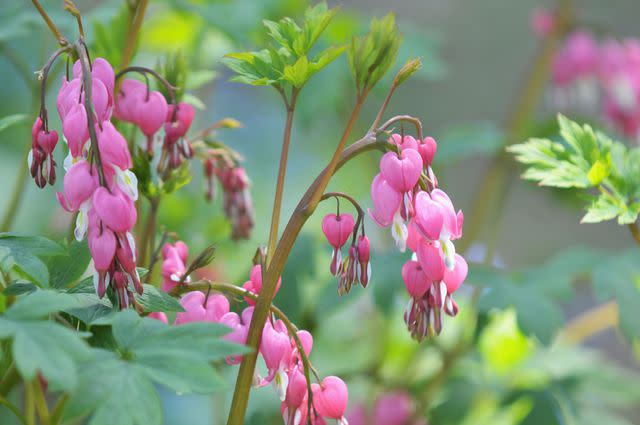
The Spruce / Evgeniya Vlasova
With its delicate ferny foliage and pretty heart-shaped flowers that dangle from graceful, arching stems, bleeding hearts (Lamprocapnos spectabilis) might look like a menu item for deer.
However, neither deer, rabbits, nor heavy shade deters the spring blossom show of these old-fashioned favorites. Shade-loving woodland plants bloom in the cool of spring, so bleeding hearts go dormant if exposed to too much sun or heat.
USDA Hardiness Zones: 3 to 9
Color Varieties: Pink, red, white
Bloom Time: Late spring to early summer
Sun Exposure: Shade to part shade
Soil Needs: Rich and moist
Coneflower
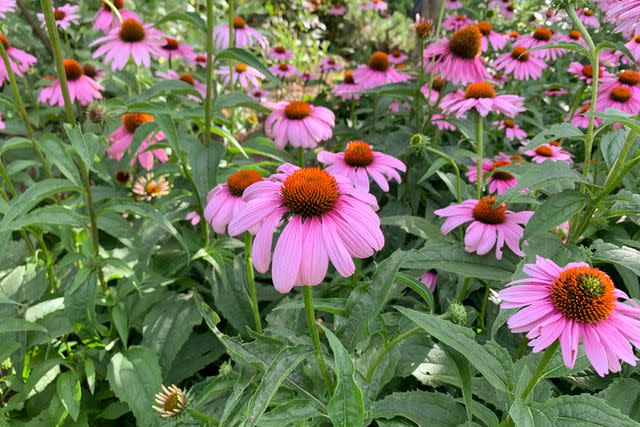
The Spruce / Leticia Almeida
Is there anything this versatile plant cannot do? Coneflowers (Echinacea purpurea) attract butterflies, nourish bees and wild birds, self-seed non-aggressively, and grow in sun or partial shade. The new varieties of coneflowers make it a designer's delight, it blooms longer than many perennial plants and tolerates heat and drought conditions well.
USDA Hardiness Zones: 3 to 9
Color Varieties: Purple, white, pink, lavender, red, yellow, orange
Bloom Time: Mid-summer to early fall
Sun Exposure: Full sun to part sun
Soil Needs: Well-drained fertile soil high in organic matter
Corydalis

The Spruce / Evgeniya Vlasova
Not your average deer-resistant shade plant, the corydalis is noteworthy for its beautiful fern-like foliage and long blooming period. Gardeners in areas with cool summers have the best luck growing yellow or blue-blooming corydalis. They can become somewhat aggressive self-sowers when planted in favorable conditions.
USDA Hardiness Zones: 5 to 7
Color Varieties: Blue, yellow
Bloom Time: Late spring to early summer
Sun Exposure: Part to full shade
Soil Needs: Well-drained, humus-rich, consistently moist soil
Coreopsis
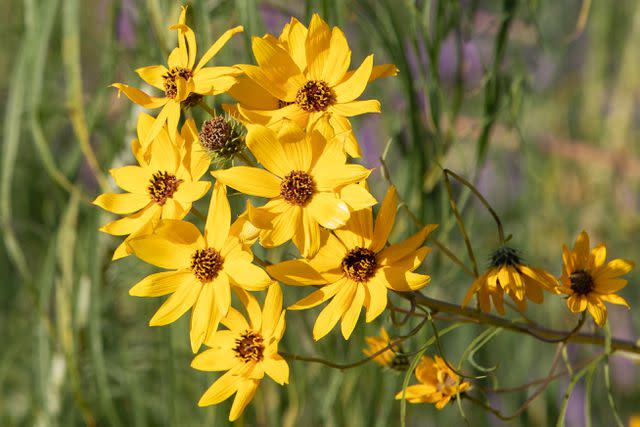
The Spruce / Leticia Almeida
Deer seldom browse lanceleaf coreopsis plants or other species in this genus, and they are easy to grow because they are drought-tolerant and need no fertilizing. Deadheading spent blooms encourages more flowers throughout the summer.
USDA Hardiness Zones: 4 to 9
Color Varieties: Yellow, orange, pink, red, maroon
Bloom Time: Late spring to late summer (and sometimes into fall)
Sun Exposure: Full sun to partial shade
Soil Needs: Well-draining, sandy soil
Daffodil

The Spruce / Leticia Almeida
On the spring bulb spectrum, daffodils and tulips are on opposite ends. Deer do not care for the daffodil's milky sap, nor do squirrels or rabbits. Daffodils have the added benefit of multiplying over the years, unlike tulips, which tend to dwindle in number each season. New exciting double forms and pinky-salmon colors make daffodils an essential part of any spring deer-resistant garden.
USDA Hardiness Zones: 3 to 8
Color Varieties: Yellow, white, orange, apricot, pink
Bloom Time: Late winter into spring
Sun Exposure: Full sun to partial shade
Soil Needs: Moist but well drained
Lavender

The Spruce / Leticia Almeida
Lavender (Lavendula spp.) features foliage and blooms that emit the sweet perfume so beloved by potpourri makers, but it is a scent deer dislike. In warmer climates, you can grow lavender into fragrant deer deterring hedges, but they struggle a bit in cooler temperatures. In either case, lavender is not a long-lived perennial plant.
USDA Hardiness Zones: 5 to 9
Color Varieties: Purple, violet-blue, rose, pale pink, white, and yellow (rare)
Bloom Time: Summer
Sun Exposure: Full sun
Soil Needs: Well-draining soil, preferably sandy
Lungwort
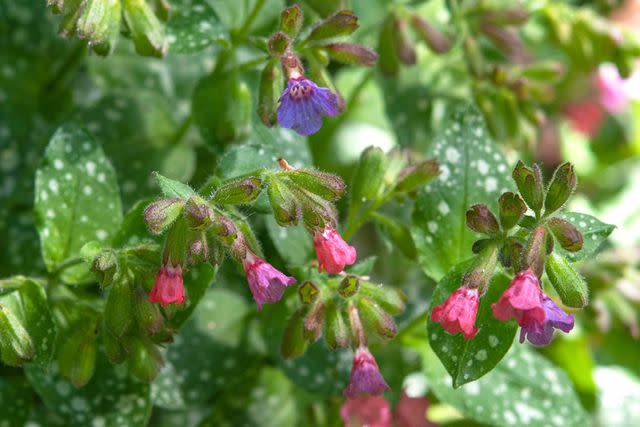
The Spruce / Evgeniya Vlasova
With their quirky name and freckled foliage, Lungwort (Pulmonaria spp.) are unsung heroes of the shade garden. These low-maintenance plants not only repel deer, but they also grow in the dense shade of walnut trees with no signs of the juglone toxicity that plague other shade lovers like azaleas. They are among the earliest blooming spring flowers. 'Raspberry Splash' is a common cultivar reportedly also resistant to powdery mildew.
USDA Hardiness Zones: 4 to 8
Color Varieties: Brilliant blue, pink, and white
Bloom Time: Late winter to early spring
Sun Exposure: Part shade to full shade
Soil Needs: Organically rich, well-drained, moist soil
Yarrow

The Spruce / Adrienne Legault
Yarrow (Achillea millefolium) is a tall, long-blooming perennial with feathery foliage and bright clusters of flowers that butterflies love. This plant blooms right through summer and into fall, and it's drought-tolerance makes it a popular addition to xeriscape gardening.
However, it is viewed as an aggressive weed in some parts of the US, so consider if it's appropriate for your yard before planting. Common yarrow is also toxic to pets.
USDA Hardiness Zones: 3 to 9
Color Varieties: Purple, white, yellow, pink, orange, red, bi-colored
Bloom Time: Late spring to early fall
Sun Exposure: Full sun
Soil Needs: Well-drained
Poppy

The Spruce / Leticia Almeida
Poppy varieties, including the common poppy (Papaver rhoeas) are easy to grow from seed and bloom for about two weeks. In addition, many poppies also have ornamental seed pods that endure for weeks afterward. The toxicity of the poppy plant causes deer to steer clear.
USDA Hardiness Zones: 3 to 9, depending on the variety
Color Varieties: White, pink, red, orange, yellow, purple
Bloom Time: Late spring through summer
Sun Exposure: Full sun
Soil Needs: Average well-drained soil
Warning
Poppies are toxic if consumed. Keep out of the reach of children and pets.
Annual Vinca

The Spruce / Lacey Johnson
Annual Vinca (Catharanthus roseus), also known as the Madagascar periwinkle, is a hardworking annual that shrugs off deer, rabbits, and drought. Whether you need reliable bedding plants, something for the container garden, or a showy edging plant, vinca, with its glossy foliage and delicate flowers, fills all those niches.
These plants have a long bloom period, but flowering is more abundant in hot weather. Provide a balanced flower fertilizer every other week, and don't worry about deadheading.
USDA Hardiness Zones: 4 to 9
Color Varieties: White, red, purple, many shades of pink, peach, and lavender; comes in solid colors or with a contrasting eye
Bloom Time: From late spring until frost
Sun Exposure: Full or part sun
Soil Needs: Average well-drained soil
Winter Aconite

The Spruce / Evgeniya Vlasova
In mid to late winter, the bright yellow flowers of winter aconite (Eranthis hyemalis) push their way up through the snow. You can plant these harbingers of spring along paths and open woodland areas because deer will pass them by. In the fall, plant winter aconite tubers three inches deep after soaking the tubers in water to wake them from dormancy.
Winter aconite is an excellent choice to plant under deciduous trees in areas that are sunny in winter but shady in summer. If your winter aconite patch receives regular irrigation, you will enjoy an ever-enlarging naturalized collection of these blooms.
USDA Hardiness Zones: 3 to 7
Color Varieties: Bright yellow
Bloom Time: Late winter to early spring
Sun Exposure: Full sun in winter, shade in summer
Soil Needs: Organically rich, medium moisture, well-drained soils
Astilbe

The Spruce / Evgeniya Vlasova
These clumping perennials in the Saxifragaceae family prefer a moist, shady spot. Astilbe species produce tall, upright stems up to three feet tall with fern-like foliage that is tender in bright sun. It blooms in late spring with pink, red, purple, or white plumes of flowers about six inches to two feet long. The plant attracts butterflies but is resistant to nibblers like rabbits and deer.
USDA Hardiness Zones: 3 to 8
Color Varieties: Pink, red, purple, white
Bloom Time: Late spring to late summer
Sun Exposure: Partial sun to partial shade
Soil Needs: Loamy, moist
Liatris (Liatris spicata)

The Spruce / Evgeniya Vlasova
Liatris (Liatris spicata) is a sun-loving herbaceous perennial. Also called a blazing star, it features unusual tiny star-like blossoms on the end of long spikes. It is a wildflower native to the U.S., blooming from July to late fall. The primary species is bright purple but comes in pink and white cultivars. It attracts birds, bees, and butterflies, but deer seem to pass it by.
USDA Hardiness Zones: 3 to 9
Color Varieties: Purple, pink, white
Bloom Time: Mid-summer to late fall
Sun Exposure: Full
Soil Needs: Moist, well-drained
'May Night' Salvia

The Spruce / Evgeniya Vlasova
'May night' salvia (Salvia sylvestris 'May Night') is also known as woodland sage. It is a herbaceous perennial in the mint family with small flowers on spikes that reach up to two feet tall. Its lance-shaped leaves have culinary uses, but deer do not favor them due to their fragrance. When deadheaded, it blooms from May throughout the entire summer.
USDA Hardiness Zones: 4 to 8
Color Varieties: Dark purplish-blue
Bloom Time: Late spring to late summer
Sun Exposure: Full
Soil Needs: Well-drained
Shasta Daisy

The Spruce / Evgeniya Vlasova
Shasta daisies (Leucanthemum x superbum) are cheerful white-petaled flowers with yellow centers and deep green foliage. They are loved by pollinators but are usually passed over by deer. Once established, they are vigorous growers and spread easily. Shasta daisies prefer rich, fertile soil but can also grow in poor soil. These plants are also drought, pest, and disease-resistant.
USDA Hardiness Zones: 5 to 9
Color Varieties: White or pale yellow
Bloom Time: Late spring to early fall
Sun Exposure: Full, partial
Soil Needs: Loamy, moist but well-drained
Lily of the Valley

The Spruce / Evgeniya Vlasova
Lily of the valley (Convallaria majalis) is not a lily but rather a member of the asparagus family. Its leaves look lily-like, with delicate, fragrant bell-shaped blooms in spring and orange-red berries in fall. This ground cover spreads gradually and forms dense colonies. All parts of this plant are poisonous to humans and animals because they contain glycosides.
USDA Hardiness Zones: 5 to 9
Color Varieties: White
Bloom Time: Spring
Sun Exposure: Partial shade
Soil Needs: Well-drained
Butterfly Bush

The Spruce / Evgeniya Vlasova
Butterfly bush (Buddleia davidii) is a deciduous shrub that flowers in summer. The impressive floral spikes or clusters come in a wide range of colors, attracting pollinators but detracting deer. Some of these shrubs can grow up to 12 feet tall, while others are more compact. The plant hails from Asia and self-seeds readily. It is considered an aggressive weed in some regions.
USDA Hardiness Zones: 5 to 9
Color Varieties: Purple, pink, lavender, blue, white, yellow
Bloom Time: Summer to early fall
Sun Exposure: Full
Soil Needs: Moist, well-drained
Marigold

The Spruce / Gyscha Rendy
Marigolds (Tagetes spp.) are richly colored annuals reliably blooming in yellow, gold, and coppery colors with fern-like, serrated foliage. These plants are fast-growing, achieving blooms within a few months when planted from seed. Their fragrance keeps deer and rabbits away.
USDA Hardiness Zones: 2 to 11
Color Varieties: Yellow, orange, white, red, gold, bicolor
Bloom Time: Early summer to late fall
Sun Exposure: Full
Soil Needs: Moist, well-drained
Sunflower
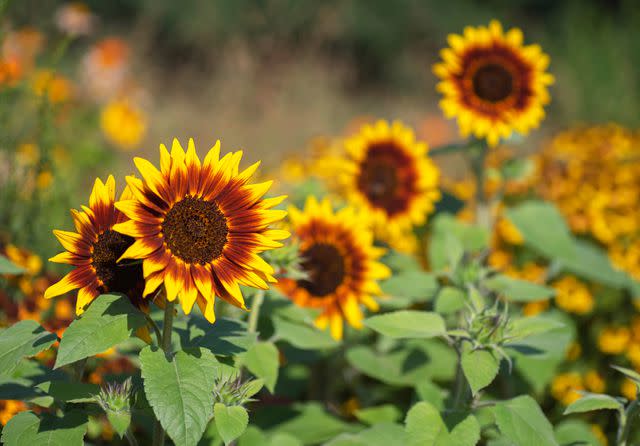
The Spruce / Evgeniya Vlasova
Sunflowers (Helianthus annuus) are annuals in the aster family. Their large flowers can grow up to 6 or more inches wide with a prominent central disk that produces hundreds of seeds that birds adore. Sunflowers grow on a hairy, sturdy, upright stem that can be several feet tall, depending on the variety. Deer shun the plant's rough leaves.
USDA Hardiness Zones: 2 to 11
Color Varieties: Shades of yellow, gold, orange, cream, maroon, and mahogany; bicolor or solid
Bloom Time: Mid-summer to early fall
Sun Exposure: Full
Soil Needs: Well-drained
Foxglove

The Spruce / Evgeniya Vlasova
Foxgloves (Digitalis purpurea) are tall, flowering plants with eye-catching, tubular pink, white, or purple blooms. These fast-growing biennial plants can grow up to 5 feet tall. They produce foliage in their first year and giant flower stalks the second year before they die. Foxgloves are self-seeding, continuing to proliferate in a patch year after year. All parts of this plant are toxic to humans and animals. Deer tend to steer clear of toxic plants.
USDA Hardiness Zones: 4 to 10
Color Varieties: Pink, purple, red, white, yellow
Bloom Time: Early summer
Sun Exposure: Full, partial
Soil Needs: Loamy, well-drained
Heliotrope

The Spruce / Evgeniya Vlasova
Heliotrope is a genus of flowering plants in the Boraginaceae family with stunning, fragrant flowers. These plants are sun-lovers that turn to follow the sun. Deer don't like the scent or the rough, sandpaper-textured leaves. They are perennial in warmer zones but are frost-tender and grown as annuals in cooler zones. Deadheading encourages more blooms and bushy, denser growth.
USDA Hardiness Zones: perennial in zones 9 to 11; annual elsewhere
Color Varieties: White, lavender, purple
Bloom Time: Summer to fall
Sun Exposure: Full
Soil Needs: Well-drained
Zinnia

?The Spruce / Letícia Almeida
Zinnias (Zinnia elegans) are perennial in warm climates and are grown as deer-resistant annuals elsewhere. They require little care, although powdery mildew can be a problem if you don't space the plants to allow enough air circulation. The brightly colored flat flower heads bloom all summer up through the fall.
Deadheading spent flowers encourages more blooms. Varieties can be compact or tall (up to 4 feet high). The rough-textured leaves usually prevent deer from nibbling.
USDA Hardiness Zones: 2 to 11
Color Varieties: White, lavender, purple
Bloom Time: Summer to early fall
Sun Exposure: Full
Soil Needs: Well-drained
Lilac

The Spruce / Evgeniya Vlasova
Common lilac (Syringa vulgaris) is a member of the olive family and is a low-maintenance landscaping plant with a strong fragrance and abundant flower clusters in many colors. Deer tend to avoid common lilac, but young plants are vulnerable just after planting. The plant can survive and regrow if the root system is not damaged.
USDA Hardiness Zones: 3 to 7
Color Varieties: Lavender, purple, white, pink, magenta
Bloom Time: Spring
Sun Exposure: Full
Soil Needs: Moist but well-drained, loamy, sandy, clay
Forsythia

The Spruce / Evgeniya Vlasova
Forsythia species are fast-growing deciduous flowering shrubs in the olive family. These early-spring bloomers are low-maintenance shrubs that flower before they leaf out. Compact forsythia varieties grow a few feet tall, while larger varieties can reach up to ten feet tall. Deer rarely nibble on these shrubs, but every plant that's not toxic is fair game to a starving deer.
USDA Hardiness Zones: 5 to 8
Color Varieties: Yellow
Bloom Time: Spring
Sun Exposure: Full, partial
Soil Needs: Moist, well-drained
Rose of Sharon
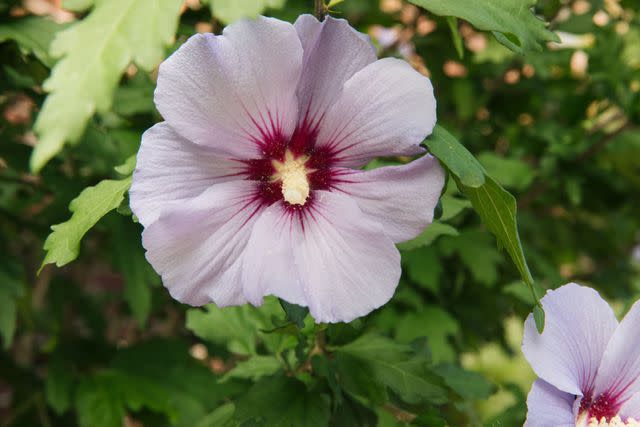
The Spruce / Letícia Almeida
Rose of Sharon (Hibiscus syriacus) is a deciduous hibiscus species that produces showy five-petal blooms with a prominent stamen, often with a contrasting dark-colored throat. It can be planted in the spring or fall, growing about one to two feet per year. It starts flowering in late spring or early summer and continues to bloom in fall. This shrub is tolerant of urban conditions, heat, humidity, poor soil, and drought. Rutgers University rates this plant as "seldom severely damaged" by deer.
USDA Hardiness Zones: 5 to 8
Color Varieties: Pink, purple, lavender, red, peach, orange, bluish-lavender, white; often with dark throats
Bloom Time: Late spring to early fall
Sun Exposure: Full to partial sun
Soil Needs: Moist, well-drained
Floss Flower
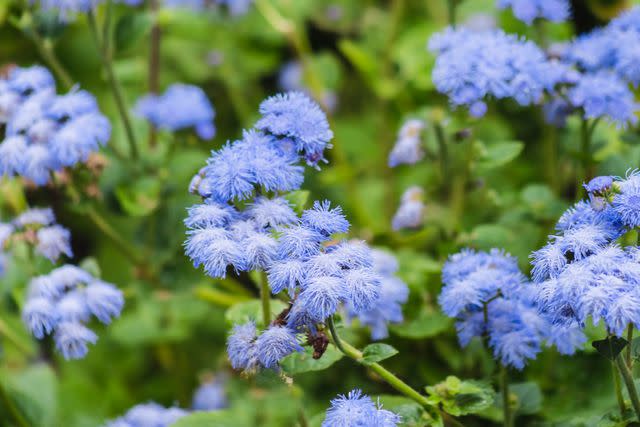
The Spruce / Autumn Wood
Ageratum, commonly known as floss flower, is in the aster family. This annual blooms late spring through the first frost of fall. Some varieties grow up to 30 inches tall. Floss flower comes in several colors but is prized for their periwinkle blue shade.
Ageratum grows best in sunny locations in moist, well-draining soil. It tolerates periods of dryness but performs best if regularly watered. The rough-texture foliage of floss flowers keeps deer at bay.
USDA Hardiness Zones: 2 to 11
Color Varieties: Purplish blue, periwinkle blue, pink and white
Bloom Time: Late spring to early fall
Sun Exposure: Full, partial
Soil Needs: Moist, well-drained
Verbena

The Spruce / Letícia Almeida
Verbena species are prized by pollinators such as bees, hummingbirds, and butterflies, but you shouldn't have to worry about deer eating these plants. Verbena are hardy perennials in zones 8 to 11 but are commonly grown as annuals. They produce clusters of colorful flowers that bloom continuously from spring to fall. Deadhead common garden verbena during the growing season to encourage new blooms and extend the blooming season.
USDA Hardiness Zones: 8 to 11
Color Varieties: White, red, purple, pink, lavender, bi-colored
Bloom Time: Spring to fall
Sun Exposure: Full
Soil Needs: Well-drained
Snapdragon
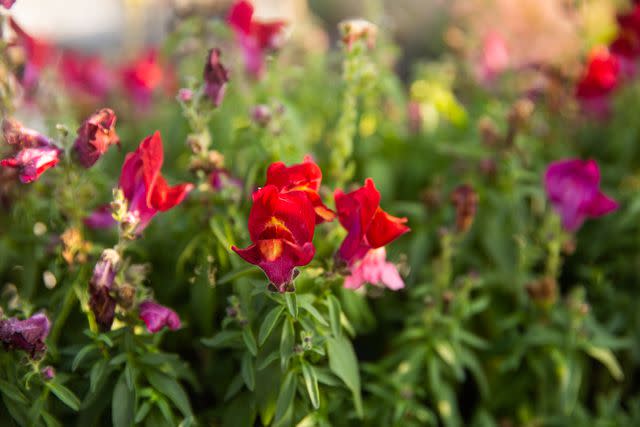
The Spruce / Phoebe Cheong
Snapdragons (Antirrhinum majus) are short-lived garden perennials in USDA hardiness zones 8 through 11. They are grown as cool-weather annuals in other climates. There are many varieties of different sizes, from a few inches tall to spires approaching four feet.
Deer-resistant snapdragon blooms are available in many colors, and they prefer cooler weather in spring and fall. Flower production slows down once the temperatures heat up.
USDA Hardiness Zones: 7 to 11
Color Varieties: White, yellow, pink, red, orange, peach, purple, violet
Bloom Time: Early spring to late fall
Sun Exposure: Full, partial
Soil Needs: Moist, well-drained
Bee Balm
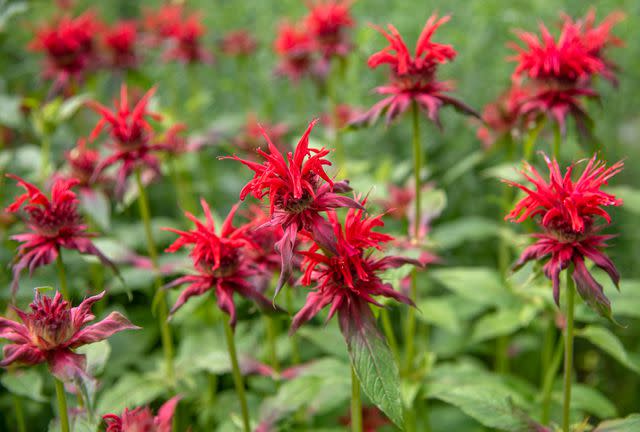
The Spruce / Evgeniya Vlasova
Bee balm (Monarda spp.) are North American wildflowers of the mint family with bright, vibrant flowers and a long bloom season. Bee balm are somewhat weedy plants growing up to four feet tall, with downy oval leaves on the undersides.
They tend to spread aggressively through underground rhizomes and self-seeding. The flowers look like colorful hairy clusters that attract bees and butterflies. These plants are hummingbird favorites too. However, their scent repels deer.
USDA Hardiness Zones: 3 to 9
Color Varieties: Red, purple, pink, white, lavender
Bloom Time: Summer
Sun Exposure: Full, partial
Soil Needs: Moist
Monkshood

?The Spruce / Autumn Wood
Native to Europe and Asia, monkshood (Aconitum napellus) is a tall herbaceous perennial that blooms late in the summer and fall and handles partial shade well. This slow grower is named for resembling the cowl on a monk's habit. It produces racemes of azure blue, pink, yellow, or white flowers on sturdy, unbranched stems. It needs plenty of water to thrive. This plant is toxic, which is likely the reason deer shun it.
USDA Hardiness Zones: 3 to 8
Color Varieties: Blue, purple, white, yellow, pink
Bloom Time: Mid summer to early fall
Sun Exposure: Full, partial
Soil Needs: Moist, well-drained
Bearded Iris
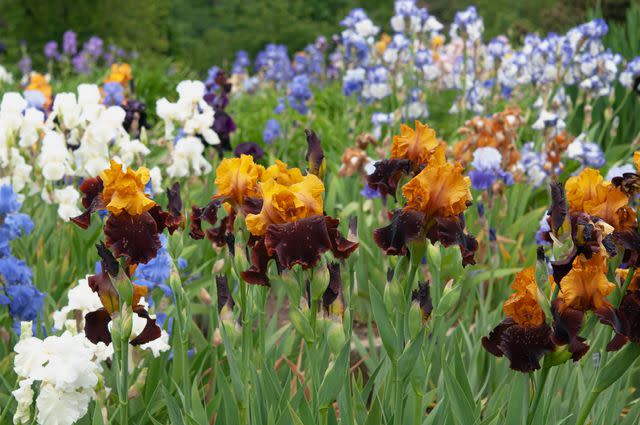
The Spruce / Evgeniya Vlasova
The bearded iris (Iris germanica) is one of the most popular and easiest to grow irises. It has sword-like leaves and flowers with spreading or drooping lobes. This plant usually flowers in its first year, preferring well-draining soil and a sunny spot. Its rhizome must be partially exposed to sunlight for the plant to flower. Bearded irises are toxic to humans, dogs, cats, and horses. It's likely the flower fragrance and perhaps the sharp foliage that keeps deer away.
USDA Hardiness Zones: 3 to 9
Color Varieties: Red, orange, yellow, blue, purple, brown, white, pink, and many bicolors
Bloom Time: Spring
Sun Exposure: Full
Soil Needs: Well-drained
Peonies

The Spruce / Evgeniya Vlasova
Peonies (Paeonia officinalis) are one of the longest-lived garden plants, sometimes handed down from generation to generation of gardeners. Their blooms are fluffy, full, ruffled, or single. These top-heavy flowers often need staking and shelter from winds so they don't flop and bend. They have a strong scent that deer don't like. Peonies are toxic to animals and humans.
USDA Hardiness Zones: 3 to 9
Color Varieties: White, pink, rose, red, deep purple, and coral
Bloom Time: Late spring to early summer
Sun Exposure: Full
Soil Needs: Well-drained
Planting Tips to Avoid Deer in Your Garden
Whether you have deer-resistant plants or not, deer might still drop in. Smart planting techniques can help make your garden less appealing to wildlife and often allows you to keep deer-friendly plants safe. Some landscaping options to try include:
Create a physical barrier: Fitting chicken wire or netting around the plants deer like to nibble on can be enough to keep them at bay.
Elevate plants: Put deer-favorite species in high-up hanging baskets, balconies, enclosed decks or patios, or difficult-to-reach raised beds.
Plant deer-resistant species strategically: Using tall plants deer don't like to block them from accessing species they love might work. And, by putting the species they love closer to your home, deer might be less likely to eat them in their efforts to avoid contact with humans.
Look after your landscape: Keeping your landscape tidy and free from debris makes it less attractive to deer. They're less likely to find a hidden spot with lots of leaf litter to bed down on.
Plant deer-resistant hedges: Deer don't like boxwoods. So using them to create a border around your landscape can help keep deer away from other plants.
Create a terraced landscape: Deer aren't fans of steep slopes and narrow beds, so a terraced garden design could be the way to go.
Frequently Asked Questions
What smells do deer hate the most?
Studies show that putrescent egg solids are one of the most effective tested area repellants to apply to the ground around plants. Scientists believe the sulfurous whiff of decomposing eggs mimics the smell of predator urine. So the deer are kept away because of their fear rather than the unpleasant smell. However, there isn't one smell all deer hate the most, some smells are just more repellant to them than others.
Do coffee grounds keep deer away?
There are many ways to use coffee grounds in your garden. While no scientific evidence suggests they are an effective deer repellent, the strong smell could be a deterrent. Even if they don't keep deer at bay, coffee grounds around your plants act as a natural fertilizer.
What naturally keeps deer away from plants?
A combination of visual and audio deterrents might keep deer away from your plants. Some common visual deterrents include scarecrows, flags, or motion-activated strobe lights. Audio deterrents, like cans on strings or motion-activated alarms, might help, although they aren't great if close neighbors surround you. Motion-activated sprinklers also work for some homeowners.
Read Next: 15 Deer-Resistant Annuals to Keep Your Garden Safe
